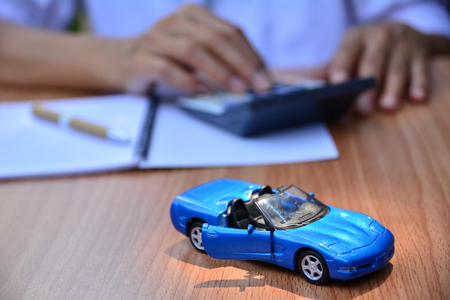1. Understand Your Lease Agreement
If youre thinking about ending your car lease early and want to avoid losing money, the first step is to really understand your lease agreement. This document is packed with important details that can help you make smart decisions. Before you do anything, take a close look at some key terms that can impact how much it costs to break your lease.
Key Terms in Your Car Lease
Car leases might seem complicated, but knowing what each part means can save you from unexpected expenses. Here are some common terms youll see:
| Term | What It Means |
|---|---|
| Early Termination Fees | Charges you pay if you end your lease before the contract is up |
| Residual Value | The estimated value of the car at the end of your lease; affects buyout price and fees |
| Mileage Limits | The maximum number of miles you can drive without extra charges; going over can get expensive |
Why These Terms Matter
Understanding these terms helps you figure out exactly whats at stake. For example, if your early termination fee is high, it might not be worth ending your lease unless you have a really good reason. If youve driven way over your mileage limit, breaking the lease could cost even more. Knowing the residual value tells you how much youd need to pay if you decide to buy the car instead of returning it.
Tip: Get a Copy of Your Agreement
If you dont already have a copy of your lease agreement handy, ask your dealership or leasing company for one. Go through it line by line or ask a trusted friend or advisor to help explain anything thats confusing. The more you know now, the less likely youll be surprised by extra fees later on.
2. Consider Lease Transfer or Swap Options
If youre looking to get out of your car lease early without losing money, one of the best solutions is a lease transfer, also known as a lease swap. This allows you to hand over your lease contract to someone else who takes over the remaining payments and responsibilities. There are popular online platforms like Swapalease and LeaseTrader that help connect you with people interested in taking over leases.
How Does a Lease Transfer Work?
Most leasing companies in the U.S. allow for lease transfers, but it’s important to check your specific contract or contact your leasing company first. Here’s how the process typically works:
| Step | Description |
|---|---|
| 1. List Your Lease | Create a listing on platforms like Swapalease or LeaseTrader with details about your vehicle and current lease terms. |
| 2. Find a Buyer | Interested buyers will contact you through the platform if they want to take over your lease. |
| 3. Apply for Transfer | The buyer submits a credit application to your leasing company for approval. |
| 4. Complete Paperwork | If approved, both parties sign the necessary documents to transfer the lease legally. |
| 5. Handover Vehicle | You deliver the car to the new lessee and are released from future lease obligations. |
Benefits of Lease Transfers
- No Hefty Penalties: Avoid expensive early termination fees charged by most leasing companies.
- Relieve Yourself from Payments: Stop making monthly payments once the transfer is complete.
- Straightforward Process: Platforms guide you through each step, making it easy even if you’ve never done it before.
- Potential Incentives: You can offer incentives (like covering transfer fees) to attract more buyers, often still saving money compared to other options.
Things to Watch Out For
- Transfer Fees: Some leasing companies charge a fee for processing a lease transfer—usually between $75 and $500.
- Credit Approval: The person taking over must qualify with the leasing company, so approval isn’t guaranteed.
- Responsibility After Transfer: In rare cases, you might still be partially liable if the new lessee defaults; check your contract for “post-transfer liability.”

3. Negotiate Directly With Your Lender or Dealer
If youre looking to get out of your car lease early without taking a financial hit, one of the smartest moves is to contact your leasing company or dealership directly. Many people don’t realize that lenders and dealers are often open to working with you if you’re up front about your situation.
Why Reach Out?
Lenders and dealerships sometimes have special programs or options for people who want or need to end their lease early. These can include early buyout deals, hardship programs, or even lease transfers. The key is to ask—every lender has different policies and may be willing to work with you, especially if you have a good payment history.
Common Early Exit Options You Can Discuss
| Option | How It Works | Potential Benefits |
|---|---|---|
| Early Buyout | You pay the remaining balance on your lease, sometimes at a reduced rate. | No more monthly payments; possible savings if the car’s market value is high. |
| Hardship Program | If you’re facing financial difficulties, some lenders offer relief programs. | Reduced fees, waived penalties, or easier exit terms. |
| Lease Transfer/Swap | You transfer your lease to another qualified person. | Avoid early termination fees; someone else takes over payments. |
How to Start the Conversation
Call or email your leasing company’s customer service and explain your situation honestly. Ask about any early termination options they offer and see if there’s room for negotiation. Don’t be afraid to mention if you’ve been a reliable customer—they may be more willing to help you out!
4. Sell the Leased Vehicle Yourself
If you’re looking for a smart way to get out of your car lease early without losing money, selling the leased vehicle yourself could be a great option. Here’s how it works and what you need to know.
How Does Selling Your Leased Car Work?
Most leases allow you to buy the car at a set price, called the payoff or buyout amount. If your car is worth more on the open market than this payoff amount, you can buy out your lease and then sell the car to someone else—possibly breaking even or making a small profit.
Steps to Sell Your Leased Car
- Check Your Lease Buyout Price: Contact your leasing company or check your lease agreement to find out how much it will cost to buy out your lease.
- Research Your Car’s Market Value: Use resources like Kelley Blue Book, Edmunds, or local listings to determine what your car could sell for privately or to a dealer.
- Compare Values: See if your car’s market value is higher than the buyout price. If so, you’re in a good spot!
- Arrange Financing (if needed): If you don’t have cash on hand for the buyout, some banks and credit unions offer short-term auto loans just for this purpose.
- Buy Out the Lease: Pay off the leasing company and become the official owner of the car.
- Sell the Car: List your car for sale privately, or see if a dealership (including online dealers like CarMax or Carvana) will give you a better offer.
Quick Comparison Table
| Step | Description | Potential Outcome |
|---|---|---|
| Check Buyout Price | The amount required to purchase your leased vehicle | Know your financial starting point |
| Market Value Research | Estimate how much buyers would pay for your car | You may profit if value exceeds buyout price |
| Sell Yourself vs. Dealer Offer | Selling privately usually brings more money than selling to a dealer | Bigger chance of breaking even or making money |
Things to Watch Out For
- Fees: Some leases have early termination or transfer fees—check with your lessor first.
- Titling Issues: Not all lenders let you sell directly to a third party; sometimes you’ll need to buy the car yourself first before reselling.
- Takes Effort: You’ll need to handle paperwork, payment collection, and possibly meet with buyers.
This strategy works best when used cars are in high demand and prices are strong. Always double-check all numbers before moving forward!
5. Explore Alternative Solutions
Getting out of a car lease early without losing money isn’t always easy, but there are several alternative solutions you can consider. Depending on your situation and your leasing company’s policies, these options may help you avoid costly penalties.
Subleasing Your Lease
One popular option is to sublease your vehicle to someone else. This is often called a “lease transfer” or “lease assumption.” Some companies allow you to transfer the remainder of your lease to another person, who takes over payments and responsibilities. Before going this route, check with your leasing company to confirm if subleasing is permitted and if there are any fees involved. Websites like Swapalease and LeaseTrader make it easier to find someone interested in taking over your lease.
Pros and Cons of Subleasing
| Pros | Cons |
|---|---|
| No early termination fees | Transfer fees may apply |
| Avoid negative equity | Not all leases allow transfers |
| May save on monthly payments | Requires finding a qualified new lessee |
Trading In Your Leased Vehicle
If subleasing isn’t possible or desirable, consider trading in your leased car at a dealership. Sometimes, the trade-in value of your car is equal to or higher than the remaining balance on your lease (the payoff amount). If that’s the case, you could use the value towards another vehicle—either a new lease or a purchase. Dealerships are often motivated to work with you, especially if you’re planning to get another vehicle from them.
How Trading In Works
- The dealer assesses your car’s current value.
- If the value covers your lease payoff amount, you can walk away clean.
- If not, you’ll need to pay the difference (negative equity), though sometimes this can be rolled into a new deal.
Rolling Over Your Lease Into a New Vehicle
If you want or need a different car, ask about rolling over your current lease into a new one. Some dealerships will let you end your existing lease early if you sign up for another vehicle with them. This can be convenient, but make sure to read the fine print—any outstanding payments or negative equity might be added to your new lease.
Comparison of Alternative Solutions
| Option | Main Benefit | Main Drawback |
|---|---|---|
| Subleasing/Lease Transfer | Avoid most fees; someone else takes over payments | Not available with every leasing company; may have transfer fees |
| Trade-In at Dealership | Might cover payoff amount; quick process if getting another car | Possible negative equity; dealership offers may be lower than market value |
| Lease Roll-Over | Simplifies transition to new vehicle; sometimes no cash needed upfront | Outstanding costs may be rolled into new deal, increasing total expense |
Choosing the Best Option for You
The right choice depends on your financial situation and priorities. Always check with your leasing company first for their specific rules, and compare the potential costs before making a decision. Taking time to explore these alternatives can help you exit your car lease early without unnecessary financial loss.


